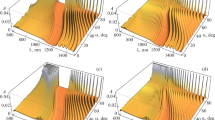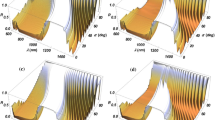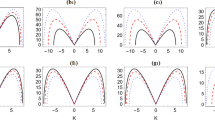Abstract
In chirped photonic crystals, the structural parameters describing a unit cell are progressively varied from a unit cell to the nearest ones. Geometric and dielectric response functions can be affected by this modulation, but here we only investigate the effect of a long-range, slowly varying, modulation of the refractive index. The Bloch modes are modified by essentially being modulated by an envelope function which adapts to the long-range dielectric function perturbation. It is shown that this envelope function obeys a simple linear Schrödinger equation of classical (non-quantum) origin. Close to a band extremum, at a gap edge, the envelope functions can be interpreted as wave functions of particles, called “energy carriers”. These carriers have a mass and come as two species, referred to as “effective photons” (for positive band curvatures) or “photonic holes” (for negative band curvatures). The energy transfer through the chirped structure can be viewed as resulting from the migration of these particles under forces implied by the long-range dielectric function modulation.
Similar content being viewed by others
References
Burt M. (1999). Fundamentals of envelope function theory for electronic states and photonic modes in nanostructures. J. Phys.: Condens. Matter 11: R53–R83
Charbonneau-Lefort M., Istrate E., Allard M., Poon J., Sargent E.H. (2002). Photonic crystal heterostructures: Waveguiding phenomena and methods of solution in an envelope function picture. Phys. Rev. B 65: 125318
Fritzsche H. (1962). Effect of stress on the donor wave functions in germanium. Phys. Rev. 125: 1560
Joannopoulos J.D., Meade R.D., Winn J.N. (1995). Molding the Flow of Light. Princeton University Press, Princeton
Keldysh L.V. (1963). Zh eksp teor. fiz. 45, 364. Sov. Phys.-JETP 18: 253
Lucas A.A., Vigneron J.P., Dereux A., Derycke I. (1994). Electron and photon tunneling in nanoscopic and mesoscopic structures. Le Vide, les couches minces 272: 193–195
Ohtaka K. (1979). Energy band of photons and low-energy photon diffraction. Phys. Rev. B 19: 5057–5067
Pantelides S.T. (1978). The electronic structure of impurities and other point defects in semiconductors. Rev. Mod. Phys. 50: 797–858
Pendry J. (1974). Low Energy Electron Diffraction. Academic Press, Inc., London
Pendry J.B., MacKinnon A. (1992). Calculation of photon dispersion relations. Phys. Rev. Letters 69: 2772–2775
Petit R. (1980). Electromagnetic Theory of Gratings. Springer-Verlag, Berlin
Author information
Authors and Affiliations
Corresponding author
Rights and permissions
About this article
Cite this article
Vigneron, J.P., Lousse, V. Theory of chirped photonic crystals. Opt Quant Electron 39, 377–385 (2007). https://doi.org/10.1007/s11082-007-9098-0
Received:
Revised:
Accepted:
Published:
Issue Date:
DOI: https://doi.org/10.1007/s11082-007-9098-0




